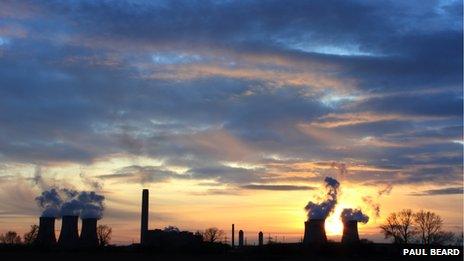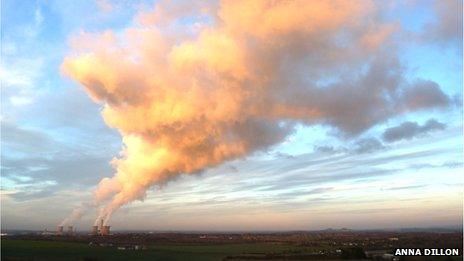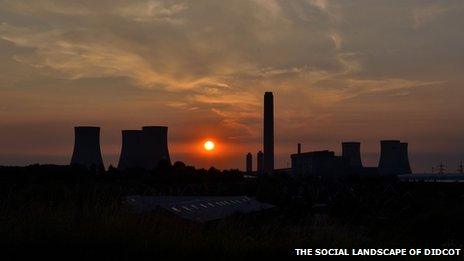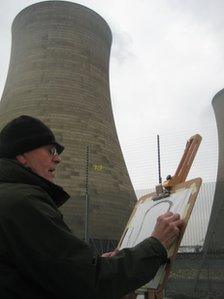Didcot power station: Blot on the landscape or local treasure?
- Published

Paul Beard, who took this picture, called the plant "our iconic Eiffel towers".

The power station has become an icon of Didcot

The sun has set on Didcot A Power Station

Martyn Bull took this picture on the morning of the plant's closure
As Didcot A Power Station was being disconnected from the national grid, Robin Mason was frantically sketching its iconic cooling towers.
"I can tell my grandchildren I did this on the last day the plant was working," he said, barely glancing away from his work.
Mr Mason likened the towers to the Angel of the North, calling them the "cathedral of the vale" and saying they should be saved for future generations.
Kelly Green, who grew up in Didcot, evidently agrees - she has an image of the towers tattooed onto her shin.
She said people living nearby would miss the sight of the power station, and did not regret getting her tattoo.
"It still reminds me of my childhood and where I come from," she said.
Local treasure
The plant was voted Britain's third ugliest building by readers of Country Life in 2003, but many in Didcot said they would be sorry to see it demolished.

Robin Mason said the view would be "uninteresting" without the towers
"For me they aren't an eye sore, they give Didcot character," said Paul Beard, who lives in the town.
Vicki Callaway, who also lives in Didcot, said the towers were disliked by people from outside the area but locals have "learned to like them".
One woman called the towers "ugly" but then refused to give her name - as though such a view would be unthinkable in Didcot.
Station manager Phil Noake said the switch-off was a "very sad time" for staff but also a celebration of the plant's work over the years.
Of the 210 staff, he said 48 had been moved to other sites and 72 will stay for at least part of the nine-month decommissioning process.
Colin Quinton, who started work at Didcot A in 1980 and will leave later this year, said life after the plant seemed "rather daunting".
"I wrote a CV the other day, the first one I have done for 33 years," he said.
"The fence here has been a sort of protection against life, but reality has now come through the gate.
"A lot of us have grown older together here and we will be sad to leave."
Reluctant switch-off
Lyn Bowen, who connected the plant to the national grid in 1970, flicked the switch to disconnect it at 14:00 GMT on Friday.
He expressed sympathy for the staff and said plants like Didcot A, which provided electricity for about two million households, should not be closed.
"We used to be self-sufficient in coal and now we are dependent on Russia, the Middle East and Norway for gas," he said. The Didcot B gas plant will continue operating.
The closure is a result of EU rules which mean highly polluting plants like Didcot had to install emission-reducing equipment or close, and its owner RWE npower chose the latter.
Ben Stewart, who climbed the plant's chimney in 2006 as part of a Greenpeace protest, welcomed the closure.

Ben Stewart and other Greenpeace activists wrote "Blair's legacy" on the plant's chimney
"If we are going to tackle Britain's emissions problem we have got to stop burning coal," he said.
Mr Stewart said he took "no pleasure" in people losing their jobs but said green energy should become the "powerhouse of British industry" and create new jobs.
Whatever the arguments, Didcot A is now disconnected.
Drawing his picture in charcoal, Mr Mason said the towers should be saved and illuminated for all to see.
With demolition due to start at the end of the year and no formal plan to preserve the plant, time for his plan is running out.
- Published22 March 2013
- Published7 March 2013